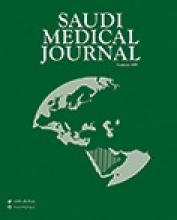Abstract
Objectives: To characterize the pattern of congenital heart diseases (CHDs) in Madinah, Saudi Arabia.
Methods: We retrospectively collected and analyzed the demographic and diagnostic details of all patients with CHDs referred at Madinah Cardiac Center (MCC) over a period of 3 years from January 2017 to December 2019.
Results: During the study period, 1,127 patients with CHDs were identified. The male to female ratio was 1.1:1, with a mean age of 8.4±2.4 years. The acyanotic CHDs were the predominant lesions, accounting for 84.8% of all cases, while the cyanotic types accounted for 13%. Patent ductus arteriosus (PDA), ventricular septal defects (VSD), atrial septal defects (ASD), coarctation of the aorta (CoA), and atrioventricular septal defect (AVSD) were the most common acyanotic CHDs and represented 27.9%, 24.8%, 18.9%, 6.4%, and 4.4% of the total cases, respectively. Tetralogy of Fallot (ToF) (8.7%), followed by transposition of the great arteries (TGA) (1.7%) and truncus arteriosus (1.1%), were the most common cyanotic CHDs. There was a male predominance of VSD, ToF, CoA, TGA, and truncus arteriosus. In contrast, PDA, ASD, and AVSD were more common in females.
Conclusion: The pattern of CHDs observed in our study and age at which the diagnosis of CHDs was made were different from the other national and international studies, which points to a diagnostic issue along with problems of awareness on the part of the general population.
Footnotes
Disclosure. Authors have no conflict of interests, and the work was not supported or funded by any drug company.
- Received June 8, 2020.
- Accepted July 23, 2020.
- Copyright: © Saudi Medical Journal
This is an open-access article distributed under the terms of the Creative Commons Attribution-Noncommercial-Share Alike 3.0 Unported, which permits unrestricted use, distribution, and reproduction in any medium, provided the original work is properly cited.






